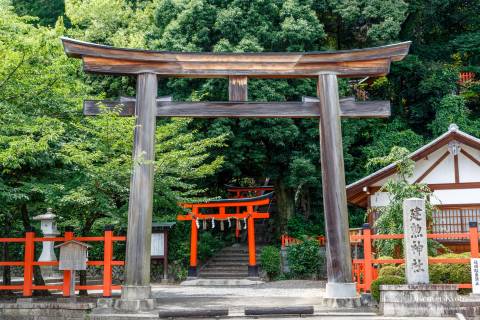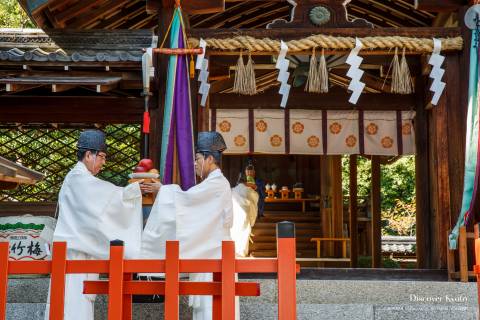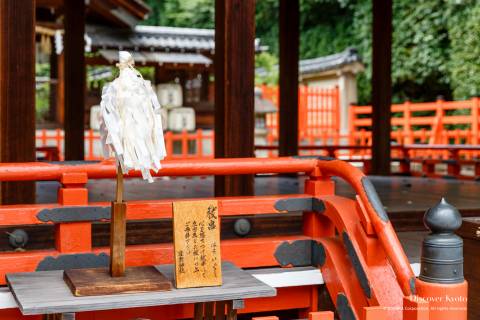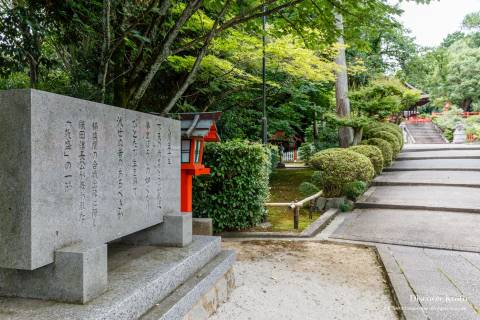Kenkun Shrine|建勲神社
Overview

Kenkun Shrine is a Shinto shrine on the top of Mt. Funaoka, a small mountain in northwestern Kyoto said to be the domain of Genbu, the tortoise guardian of the north. Kenkun Shrine enshrines Oda Nobunaga, the 16th century warlord who aimed to unify the country of Japan under one banner and helped see an end to the Warring States period in Japan. A short hike will take you to the main shrine area at the summit, which was built in the late 1800’s by decree of Emperor Meiji. The view from the shrine of Kyoto city spread out beneath the mountain is worth a look, and fans of Japan’s Warring States period will be interested in the shrine’s origins.
“A man's life of 50 years under the sky is nothing compared to the age of this world. Life is but a fleeting dream, an illusion— Is there anything that lasts forever?” - Atsumori
Features
Natural Scenery

Situated as it is on the summit of the small Mt. Funaoka, Kenkun Shrine offers a short hike that will allow you to feel removed from the city around you without leaving you winded. Multiple trails allow you to approach the shrine from a variety of directions using stairs and slopes, and seasonal blossoms such as sakura can be seen depending on the month. As a sanctuary of sorts for nature in the concrete surroundings, there is quite a lively bird population that flits from tree to tree and serenades visitors on their way to the top.
Honden (Main Sanctuary)

The Honden of Kenken Shrine is a classic example of the nagare-zukuri style of shrine architecture, characterized by a sloping roof that hangs longer over the front of the structure. Built in 1880, its roof is made in the traditional Cyprus (hinoki) thatch and it is classified as a Tangible Cultural Property. This is where the shrine deity, Lord Oda Nobunaga, is enshrined.
Haiden (Worship Hall)

Located to the east of the Honden, the Haiden is home to an offertory box and a haraigushi wand used for purification. Visitors are free to perform this on themselves in addition to making an offering and prayer by taking the wand and moving it to the left, right, left, and over themselves while thinking grateful thoughts. Peering up at the interior of the Haiden reveals portraits of eighteen of Oda Nobunaga’s thirty six loyal vassals, retainers who were determined during the shrine’s founding to have served Oda Nobunaga and his ideals meritoriously.
Lyric Monument

A stone monument along the path to the shrine serves to memorialize lyrics to the “Atsumori”, which was said to have been performed by Oda Nobunaga before he set off for the frontlines at the Battle of Okehazama in 1560. “A man's life of 50 years under the sky is nothing compared to the age of this world. Life is but a fleeting dream, an illusion— Is there anything that lasts forever?” This dance is performed each year at the Worship Hall during the shrine’s Funaoka Taisai.
History
The history of Kenkun Shrine begins with the historical figure of Oda Nobunaga (1534 –1582), a samurai warlord who fought to unify the warring states of Japan. Born in Owari (modern day western Aichi Prefecture), Nobunaga took over leadership of his clan and put a start to his ambitions in 1560 after defeating Lord Imagawa Yoshimoto of the neighboring Suruga Province. From there, Nobunaga moved on to gaining power and land, marching into the imperial city of Kyoto in 1568.
Over the course of his campaigns to unite the country Nobunaga implemented numerous policies that changed the course of the country’s future, including the career soldier system, separation of church and state, the repair of roads, the abolishment of highway barrier stations, and the use of western knowledge imported via traders and missionaries while also supporting and reviving traditional Japanese arts.
Though he eventually united much of the country under his rule, Nobunaga was betrayed for an unknown reason by one of his vassals, Lord Akechi Mitsuhide, losing his life on June 2nd, 1582, in what came to be known as the Honnō-ji Incident. In the aftermath Toyotomi Hideyoshi, one of Oda Nobunaga’s other retainers, made moves to challenge Mitsuhide, defeating him at the Battle of Yamazaki and hosting a grand funeral for his deceased lord at Daitoku-ji temple that lasted for seven days.
A temple was to be placed on top of Mt. Funaoka near Daitoku-ji in order to console Nobunaga’s spirit, but construction was halted midway and the land was instead kept in trust until hundreds of years later when Emperor Meiji decreed in 1869 that a shrine would be established there to worship Oda Nobunaga as a kami revered for responding to prayers related to ambition, better fortune, leadership in business, and warding off disaster.
In 1870, the shrine was given the name Takeisao Shrine, (though it is now commonly referred to as Kenkun Shrine, an alternate reading of the kanji characters), and in 1875 it was granted the status of an Imperial Shrine of Special Status. In 1880, Lord Nobunaga’s heir Lord Oda Nobutada was also enshrined, and in 1910 the shrine buildings that were originally at the base of the mountain were moved to the top of Mt. Funaoka, where they rest today.
Events
January 1st |
New Year’s Ritual (Saitan-sai) |
|---|---|
January 3rd |
Festival of Origins (Genshi-sai) |
Early February |
First Day of the Horse (Hatsu Uma-sai) |
February 11th | Foundation Day Festival (Kigen-sai) |
February 17th | Prays for Good Crops (Kinen-sai) |
Near April 10th | Yamato Festival (Yamato-sai) |
April 29th | Showa Festival (Showa-sai) |
June 30th | Summer Purification Ritual (Nagoshi Ōharae-shiki, Chinowa Shinji) |
July 1st |
Annual Festival (Rei-sai) |
October 19th | Funaoka Grand Festival (Funaoka Taisai) |
November 23rd | Sacred Rice Offering (Niiname-sai) |
November 23rd | Fire Ritual (Ohitaki-sai) |
December 23rd |
Tenchō Festival (Tenchō-sai) |
December 31st | End of the Year Purification (Misoka Ōharae-shiki) |
December 31st |
New Year’s Eve Ritual (Joya-sai) |
1st of Each Month | Monthly Ritual (Tsukinami-sai) |
Access
Address
〒603-8227 京都市北区紫野北舟岡町49
| TEL | 075-451-0170 |
| WEB | http://kenkun-jinja.org/english/index.html |
Admission
- General Admission: Free
Hours
- General Admission: 09:00 – 17:00
- Closed: Never
Transportation
- City Bus ⇒ Route 1, 12, 204, 205, 206, Kita 8, or M1 ⇒ Kenkun Jinja-mae Bus Stop OR Funaokayama Bus Stop ⇒ 9 minutes walking
Gallery
-




 +12
+12
